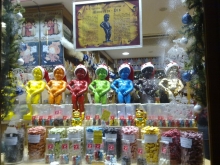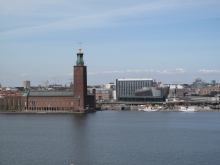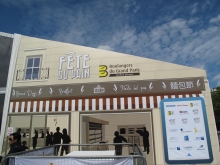
Following the article: "The princess cake", the mysterious prince charming on the packaging of the prince biscuit is also popular among girls and women. In fact, the biscuits are mostly consumed by boys and men. Actually, Roland is a knight, the protector of Bremen city, not a prince:
The product launched with the image of Roland printed on packaging of sandwich biscuit or cracker with dark chocolate filling. The image could be or means a prince charming:
This version is the original one called "Prinzenrolle" by Griesson-De Beukelaer, produced in Germany, commonly found in supermarkets in Germany:
Due to the type of cookies and price, many other companies did this type of sandwich cookies too. As the prince image is copyrighted and a trademark, there is no prince image printed on any other sandwich cookies, except this "Prinzenrolle".
The creator of this biscuit is Edouard de Beukelaer, a Belgian baker who learned how to make biscuits from England. In 1870, he bought a machine to produce his own biscuit that could keep them long and mass production. According to the story, the prince biscuit was created in Anvers (Antwerpen, Belgium) in 1870 to celebrate the “Belgium’s prince” who was the prince for 30 years and became the King Leopold II. Parc du Cinquantenaire or "park of the 50th anniversary" in Brussel was the place where the King Leopold II and his governments celebrated the 50th of Belgian independence in 1880:
As the Belgium's prince loved chocolate, but did not want to get his finger dirty. The Prince biscuit was designed apparently to this.
The similar version which has similar design on package is called "Prince de LU". Obviously, it is not from the same company, this version has no prince imaged printed on biscuit, only on the packaging:
Prince de LU has slightly different image of prince on package. The prince has brown hair and eye color instead of blond hair and blue eyes. Both carry the durandal sword if the prince image would resemble "Roland" who is the legendary paladin of Charlemagne:
Charlemagne et ses Leudes by Charles Rochet and Louis Rochet near Notre Dame de Paris, Charlemagne is the king of the franks called "Father of Europe" sitting on the horse, accompanied by Roland and Olivier. An angel of God braught this sword to Charlemagne and he gave it to Roland. In the middle ages, the king always gave the rare objects to his protectors.
Continue to read our article "Hero with Durendal sword" - the legend of Roland, a known German legend of a knight - The Bremen Roland
A Swiss version of sandwich biscuit has no prince image on it, you should know why. It is called "Chocoly.":
If you wish to try, although there is no prince to find, please check it out on our website under seasonal and specialty products.
The other version of this biscuit, Prince de Lu, Prince biscuits exist in France since 1948 and Prince becomes a LU brand in 1980. It is produced in France and sold only in some countries.
The both images pose as if the prince is throwing a biscuit, but actually it is supposed to be "Come and dance with me" or "Come with me if you wanna live"? Nowadays, this biscuit is very popular among children and adults in Europe.
The other fantasy story goes as usual, the prince was cursed by a witch and the right princess would release him to be a "Prince" again. In this case, the prince should be cursed to be printed on a cookie and not be eaten by princess (or a girl). The right princess and the right piece of cookies (it means only one cookie) of the "Prinzenrolle" would magically turn the prince image alive!! Although one of the royal princesses would try this, it won't work out.
No one believes or has any hope of it. The truth is once you open a roll, you will not stop eating until the whole package in a roll is gone!!!
The design of package and biscuits could be changed from time to time. It can happen that the prince would have green eyes or black hairs. It doesn't matter as long as the prince image is still there, it is surely sold well. Long live the prince!























